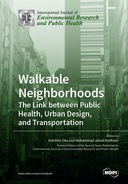Explore

Walkable Neighborhoods
Koichiro Oka and Mohammad Javad Koohsari
2020
0 Ungluers have
Faved this Work
Login to Fave
It is now widely recognized that individual-based motivational interventions alone are not sufficient to address the global pandemic of physical inactivity (lack of exercise and too much sitting time). There has been a growing interest in the effect the physically built environment can have on people’s active behaviors. The fundamental assumption is that surrounding physical environments can support active behaviors among a large number of people with long-term effects. This topic has received much attention over the last decade, mainly in the three fields of urban design, public health, and transportation. This Special Issue aims to provide multidisciplinary and evidence-based state-of-the-art research on how the locations where people live impact their active behaviors and health outcomes.
This book is included in DOAB.
Why read this book? Have your say.
You must be logged in to comment.
Rights Information
Are you the author or publisher of this work? If so, you can claim it as yours by registering as an Unglue.it rights holder.Downloads
This work has been downloaded 283 times via unglue.it ebook links.
- 256 - pdf (CC BY-NC-ND) at Unglue.it.
Keywords
- active living
- active transport
- active travel
- Africa
- age-friendly environments
- Aging
- Australia
- body mass
- built environment
- chronic diseases
- Citizen science
- City planning
- compact city
- Cycling
- Discovery Tool
- disease mapping
- elderly
- Environment
- geographic variation
- Health Outcomes
- Health promotion
- Infrastructure
- Istanbul
- liveability
- mobility management
- natural experiment
- Neighborhood
- Neighbourhood
- non-communicable diseases
- obese
- Obesity
- older adult
- overweight
- pedestrian flow
- peripheral neighbourhoods
- physical activity
- physical environment
- Policy Evaluation
- Public transport
- questionnaire
- review
- Scale
- sedentary behavior
- sedentary behaviour
- sitting
- social connectedness
- soft mobility
- Spatial Analysis
- step counts
- street network configuration
- streetscape features
- survey
- traffic safety
- urban design
- urban form
- Urban health
- walkability
- walkable environment
- walkable neighborhood
- Walking
Links
DOI: 10.3390/books978-3-03921-931-5Editions


